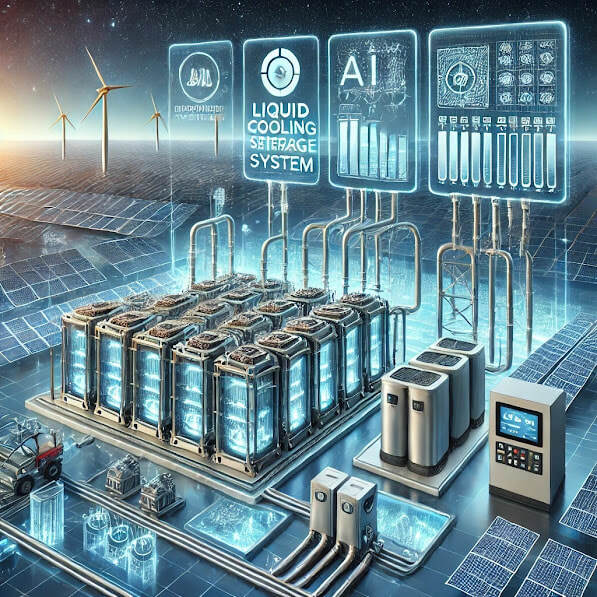As the global transition to renewable energy accelerates, stationary battery energy storage systems (BESS) have emerged as a cornerstone of grid stability. However, with growing storage capacities and increasing power density, heat management has become a critical design challenge. This is where liquid cooling systems are transforming the game.
According to BISResearch, the liquid cooling market for stationary battery energy storage system (BESS) is projected to reach $24.51 billion by 2033 from $4.23 billion in 2024, growing at a CAGR of 21.55% during the forecast period 2024-2033.
Why Is There a Growing Need for Liquid Cooling in Energy Storage Systems?
Traditional air-cooling systems, while cost-effective, struggle to handle the escalating thermal loads in modern lithium-ion BESS setups. Liquid cooling offers:
Superior heat dissipation: Ensuring uniform temperature across battery cells.
Longer lifecycle: Reducing thermal stress to extend battery health.
Compact design adaptability: Perfect for modular and containerized BESS units.
Higher efficiency: Reduces parasitic energy consumption compared to air-cooling systems.
As megawatt-scale installations become mainstream, liquid cooling is rapidly becoming the default thermal solution.
How Fast Is the Liquid Cooling Market for Stationary BESS Growing Globally?
The global market for liquid cooling in BESS is poised for rapid expansion.
Primary growth drivers include: increasing renewable energy integration, grid modernization initiatives, and the rapid deployment of large-scale energy storage projects.
Emerging economies are investing heavily in grid-scale energy storage to balance intermittent solar and wind generation.
Data-driven grid planning is further enhancing the adoption of high-density battery systems that demand advanced thermal regulation.
Request A Detailed Sample on the Liquid Cooling Market for Stationary BESS
What Key Factors Are Driving the Adoption of Liquid Cooling Solutions?
Decarbonization and Renewables Integration: As countries commit to net-zero goals, utility operators are scaling up renewable energy projects—creating demand for stable, efficient BESS cooling solutions.
Technological Advancements: Liquid-cooled systems featuring integrated pumps, chillers, and thermal plates are now optimized for safety and scalability.
Lower Total Cost of Ownership (TCO): Improved cooling efficiency and reduced energy waste lower lifetime operating costs for storage assets.
Growing EV Ecosystem Synergies: The experience gained from EV battery cooling systems is influencing the BESS cooling landscape, creating cross-sector innovation.
Regional Insights – Asia-Pacific Leads the Charge
Asia-Pacific dominates the market, driven by large-scale renewable integration in China, Japan, and South Korea.
North America follows closely with strong investments in grid modernization and data center energy storage.
Europe is also advancing rapidly, supported by decarbonization goals and smart energy infrastructure projects.
As policy incentives grow and energy transition plans mature, all regions are seeing momentum in liquid-cooled BESS installations.
How Are Industry Players Competing and Innovating in This Space?
Top players are focusing on R&D, system optimization, and collaboration with battery OEMs.
Key strategies include:
Integration of intelligent sensors and AI for real-time thermal monitoring.
Development of modular, plug-and-play cooling units for quick deployment.
Partnerships with energy utilities and EPC firms to provide turnkey thermal management solutions.
The market is seeing growing participation from both established thermal management companies and new energy tech entrants, signaling strong competitive intensity.
What Does Market Segmentation Reveal About Battery Chemistries and Cooling Needs?
While lithium-ion batteries dominate the current landscape, liquid cooling is expanding into alternative chemistries:
Sodium-ion and flow batteries, which demand precise thermal control for optimal electrochemical performance.
High-temperature and hybrid systems, where heat transfer management ensures system reliability and safety.
The technology’s adaptability across chemistries makes it a future-ready solution for the evolving energy storage ecosystem.
The Road Ahead – Future Trends and Opportunities
Integration with Smart Controls: AI-driven thermal algorithms for predictive cooling.
Standardization Initiatives: Emerging international standards for liquid cooling in BESS applications.
Sustainability Focus: Development of eco-friendly coolants and recyclable system components.
Hybrid Cooling Models: Combining air and liquid systems for optimized cost-performance balance.
Download Our ToC: Click Here!
Conclusion
Liquid cooling is not just a technical enhancement—it’s an enabler of next-generation energy resilience. As the scale of energy storage expands from megawatts to gigawatts, efficient thermal management will define the success of global BESS deployments.























